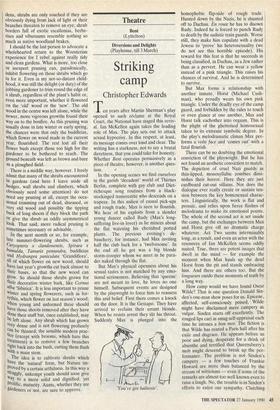Gardens
Right ho, aunts!
Ursula Buchan
It was 'one of those medium-sized houses with a goodish bit of very tidy garden and a. . . shrubbery that looked as if it had just come back from the dry- cleaner'. Bertie Wooster had a keen eye for a garden even when in the soup. These days, although he would find plenty of shrubberies belonging to the sort of house where (as he rightly deduced) somebody's aunt lived, they would not look as if they had been to the hairdresser, let alone the dry-cleaner.
At first sight, the reason for this seems simply that aunts (a sorority to which I am proud to belong) now have great difficulty finding the sort of labour prepared to spend its days groping among the dusty deutzias to pull out couch and stinging nettles, or prune Portugal laurels into tight balls with secateurs and saw.
However, just as important is the influ- ence, since Bertie's day, of a school of opinion which believes that a great deal of pruning of established shrubs is unneces- sary, and even wrong if it denies their natural habit and beauty. (Indeed this idea was advocated by William Robinson as long ago as 1870, but aunts are not noted for being quick off the mark.) The mini- malist approach to pruning finds a ready echo in many gardeners' breasts because it gives intellectual support to natural diffi- dence or indolence. In many auntly gar- dens, shrubs are only touched if they are obviously dying from lack of light or their branches threaten to remove an eye; shrub borders full of exotic escallonias, berbe- rises and viburnums resemble nothing so much as native woodland brakes.
I should be the last person to advocate a wholehearted return to the Woosterian experience for I rebel against really tidy and clean gardens. What is more, too close or inexpert pruning can, paradoxically, inhibit flowering on those shrubs which go in for it. Even in my not-so-distant child- hood, it was still the delight (or duty) of the jobbing gardener to trim round the edge of a shrub, regardless of the plant's habit or, even more important, whether it flowered on the 'old' wood or the 'new'. The old wood in the centre was left alone, while the newer, more vigorous growths found their way on to the bonfire. As this pruning was usually done in late winter or early spring, the chances were that only the buddleias, which flower on wood made in the current Year, flourished. The rest lost all their flower buds except those too high for the gardener to be bothered to reach. The ground beneath was left as brown and bare as a ploughed field.
There is a middle way, however. I freely admit that many of the shrubs encountered in gardens (and here I leave aside all hedges, wall shrubs and climbers, which obviously need some attention) do not need any pruning at all, except the occa- sional trimming out of dead, diseased, or very old wood and possibly the tipping back of long shoots if they block the path or give the shrub an oddly asymmetrical look, That said, more radical pruning is sometimes necessary or advisable.
In the next month or so, for example, late summer-flowering shrubs, such as
C, aryopteris x clandonensis, Spiraea x oumalda, Tamarix pentandra, buddleias and Hydrangea paniculata 'Grandiflora',
all of Which flower on new wood, should have last year's growths cut back almost to their bases, so that the new wood can grow. So should those shrubs grown for
their decorative winter bark, like Cornus alba `Sibirica'. It is less important to prune
winter and spring flowerers, such as for- sythia, which flower on last season's wood; when young and unformed these should have those shoots removed after they have
done their stuff but, once established, may be left alone. Any shrub which has grown
very dense and is not flowering profusely
can be thinned; the sensible modern prac- tice (except with brooms, which hate this treatment) is to remove a few branches right back into the bush, cutting them flush With a main stem.
The idea is to cultivate shrubs which have the 'natural' form, but Nature im-
proved by a certain artfulness. In this way a straggly, unkempt youth should soon give way to a more solid and dignified, yet Prolific, maturity. Aunts, whether they are gardeners or not, are sure to approve.



























































 Previous page
Previous page